
Blockchain technology for agricultural ingredients
Blockchain is an exciting new technology that presents opportunities for natural ingredient suppliers in developing countries. Although there are many advantages to using blockchain technology, there are also business risks and pitfalls. Producers in developing countries can benefit tremendously from this technology, however they should also be mindful of its limitations.
Contents of this page
1. What is blockchain?
The Merriam Webster dictionary defines blockchain as a “digital database containing information (such as records of financial transactions) that can be simultaneously used and shared within a large decentralized, publicly accessible network.”
Other definitions include:
- A blockchain is a database that stores encrypted blocks of data and then links them together to form a chronological single-source-of-truth for the data
- Digital assets are distributed instead of copied or transferred, creating an immutable record of an asset
- The asset is decentralised, allowing full real-time access and transparency to the public
- A transparent ledger of changes preserves integrity of the document, which creates trust in the asset.
- Blockchain’s inherent security measures and public ledger make it a useful technology for almost every sector
Blockchain is a recently-developed technology with very high growth potential. Bitcoin was the first major blockchain innovation. Blockchain or Distributed Ledger Technology (DLT) is a ground-breaking technology, as it provides solutions to many issues related to banking, supply chains and logistics. One of its main features is that it is decentralised and transparent. It is estimated that over 15 percent of financial institutions use blockchain technology. Figure 1 shows the estimated market size of blockchain in the financial services sector between 2018 and 2026.
After the invention of Bitcoin, investment started going towards exploring how blockchain could be used in other areas, such as health care, agriculture, insurance, transportation, voting, contract management and more. In 2014, the co-founder of Bitcoin Magazine, Vitalik Buterin, published a white paper that proposed a decentralised application platform. This represented a turning point for blockchain technology as various industries began to explore its potential. This led to the development of new types of DLTs.
In 2015, a second generation blockchain was introduced called Ethereum. It can be used to build “smart contracts”, which automatically process transactions based on a set of criteria. It can also build little computer program directly into blockchain that allow instruments like loans or bonds to be represented. This innovation has attracted the attention of corporations such as Microsoft, IBM and UBS, which have become interested in the potential of the smart contract functionality.
In the last six years, there has been a growing interest in using blockchain for applications other than cryptocurrency. Figure 2 presents some of the results of Deloitte's 2021 Global Blockchain Survey. It shows that the most common blockchain uses among respondents are secure information exchange and digital currency. Product supply chain track and trace ranked tenth.
Blockchain technology is expected to affect a wide range of industries, including healthcare, retail, mining education, agriculture and financial institutions. Research into innovation, as to how this technology can be utilised, is ongoing. The scalability of DLS still faces many challenges. These include issues regarding security, privacy and interoperability.
2. Types of blockchain
There are four major types of blockchain networks. These include public, private, hybrid and consortium. Each type has its own characteristics and applications.
Public blockchain is a type of non-restrictive, decentralised and permission-less distributed ledger technology. Anyone can join the network and verify transactions to be added to the platform. Any user can become an authorised node, i.e. be a part of the blockchain network. They can access past and current recorded data, as well as do mining or verify transactions. Users often do not know each other and strict security protocols have to followed. This type of blockchain is commonly used for Bitcoin and Litecoin.
Private blockchain is a type that operates as a closed network, and is controlled by a single entity. It uses peer-to-peer connections and decentralization, but on a smaller scale than public blockchain. Only a small number of users with specific authentication and permission can participate in that network. Users of this type of blockchain usually know and have already established a relationship of trust with each other. It is also known as a permissioned ledger or enterprise blockchain. This type of blockchain can is often used in agricultural supply chains.
Hybrid blockchain is a combination of a private and public blockchain. Users can control who gains access to which data stored in the network. It works in a closed ecosystem without the need to make everything public. In hybrid blockchain, rules can be changed as needed. Transactions are usually verified within that network, but the verification process can be also released into the public network.
A consortium blockchain is a semi-decentralised type where more than one organisation is in charge of the network. This means that a consortium formed by a group of members controls this blockchain. More than one organisation can act as a node and do mining. These types of DLTs are usually used by government organisations and banks. A consortium blockchain can also be used in agricultural supply chains.
Table 1: Types of blockchains
| Public (permission less) | Private (permissioned) | Hybrid | Consortium | |
|---|---|---|---|---|
| Advantages |
|
|
|
|
| Disadvantages |
|
|
| - Transparency |
| Uses |
|
|
|
|
Source: TechTarget
Tips:
- Each blockchain has something unique to offer. Make sure you understand the advantages and disadvantages of each type to ensure you choose the right one for your purposes.
- Use free online resources to learn more about how blockchain works. There are many free online courses that you can attend. You can obtain the relevant certifications that you can show to potential buyers. For example, ITC SME Trade Academy offers the course Introduction to Blockchain for Trade.
3. Drivers of blockchain
The implementation of blockchain technology is still in its infancy. The technology offers solutions to many problems that stakeholders in international trade must contend with, many of which are faced by suppliers of raw materials for agriculture. The increasing ethical consumerism, rising importance of sustainability, growing need for transparency, and increasing availability of technology and digitalisation in supply chains are the main drivers of blockchain use.
Figure 3: Drivers of blockchain in supply chains
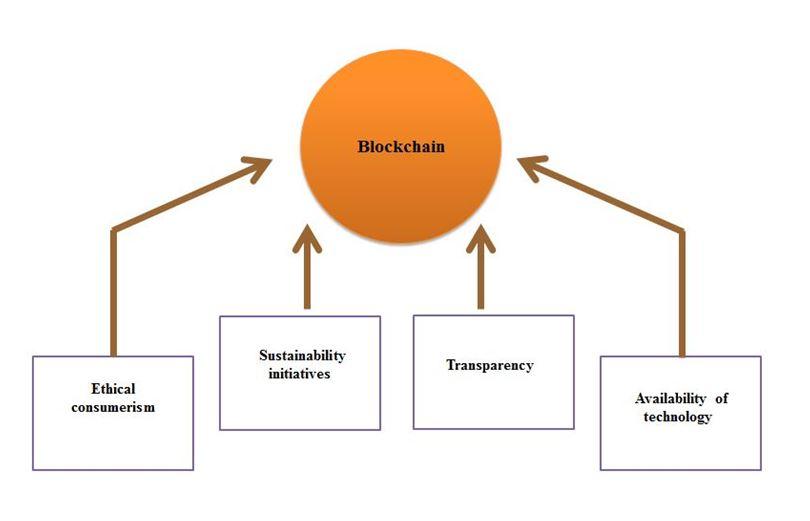
Source: Ecovia Intelligence
Ethical consumerism
Consumers are willing to pay more for products that are environmentally-friendly and sustainable. Millennials (born between the 1980s and late 1990s/early 2000s) and Generation Z (born between early 2000s and 2012) like to buy sustainable and ethical products. Figure 5 shows that Generation Z and Millennials are the most willing of all the age groups to pay a premium for sustainable products.
Around 87 percent of Generation Z and 75 percent of Millennial respondents are willing to pay a premium for sustainable products. Only around 53 percent of the Senior generation and 59 percent of the Boomer generation are willing to pay a premium for sustainable products.
Ethical consumerism is promoted in social media. Millennials and Gen Z are very active in social media; they are well connected and comment publicly on sustainability issues. As the disposable income of Gen Z and Millennials increases, they are expected to spend more money on ethical and sustainable products.
Sustainability initiatives
Many companies are making sustainability an integral part of their strategy. It has become commonplace for consumer goods companies to integrate sustainability into production processes, the sourcing of raw materials, packaging and marketing. Some of the leading food and personal care companies have incorporated sustainability initiatives into their planning.
In July 2021, The European Union Commission launched a Code of Conduct on Responsible Food Business and Marketing Practices. The Code is a part of the EU Farm to Fork Strategy and is meant to increase the affordability and availability of sustainable food options with a reduced environmental footprint. The Code has 65 signatories of which 26 are food manufacturers, 14 are food retailers, 1 is from the food service sector and 24 are associations. The Code sets out best practices and actions to be taken from farm to fork that stakeholders can voluntarily commit to. Companies, such as Nestlé, Coca-Cola, PepsiCo, Kellogg’s and Archer Daniels Midlands (ADM) are signatories.
Many food companies are setting their own sustainability targets. For example, the Anglo-Dutch consumer goods company Unilever has pledged to achieve net zero greenhouse gas emissions by 2039. It also plans to put carbon footprint labels on its products to show the greenhouse gas emissions for individual items.
The food and agribusiness giant Cargill has pledged to restore 600 billion litres of water within a decade. As part of this strategy, the company plans to support the adoption of regenerative agriculture practices in its supply chains to improve soil health. This strategy is expected to require less fertiliser and water, while maximising crop yields.
Sustainability is moving to the top of companies’ lists of priorities and companies want to cater to consumers’ needs for traceability and sustainable production. By introducing blockchain technology, companies can ensure that their claims are substantiated.
Figure 5: Cargill sustainability pledge
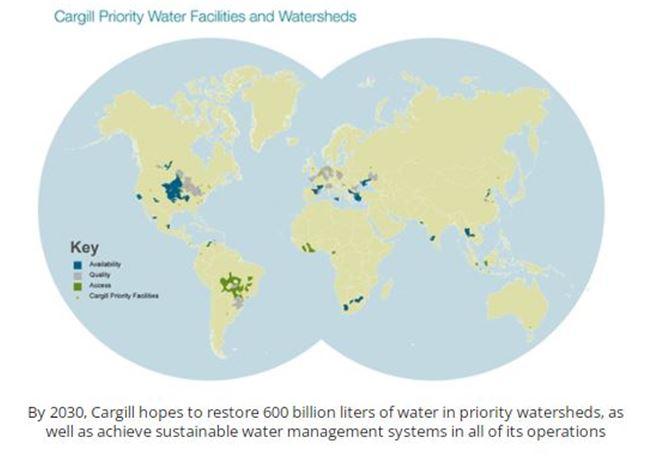
Source: delimarketnews.com
Social sustainability is also becoming increasingly important. For example, the German discounter Lidl has pledged to purchase all its coffee will come from Fairtrade- and Rainforest Alliance-certified producers. In December 2019, the Swiss fragrance and flavour company Firmenich signed the United Nations (UN) Global Compact Action Platform for Decent Work in Global Supply Chains. The platform covers areas such as communication, transparency, engagement of partners and suppliers, leadership, collaboration with other stakeholders, accountability and reporting on progress.
Transparency
Authenticity and trust are becoming increasingly important to consumers. Producers of consumer goods can cater to this consumer need by ensuring transparency throughout their supply chains. Large corporations are not perceived as transparent as they have opaque supply chains. Product development, manufacturing and distribution practices also tend to be hidden from consumers.
According to research, around 62 percent of consumers say they trust small and local businesses more than major retailers. Blockchain offers a solution that can help large organisations increase transparency and improve quality control of their products. Blockchain offers a solution, enabling corporations to begin eliminating the “trust deficit” they have with customers, and to reduce the risk of product failures and scandals.
Availability of technology
Technology and digitalisation are becoming increasingly important in supply chains. The COVID-19 pandemic has forced companies to rethink their attitudes towards digital technologies. Stakeholders are introducing digital technologies in new areas. New technologies are being introduced, such as supply chain-related software, applications and devices. These innovations have been subjected to testing since the beginning of the pandemic and are now being introduced into operations. According to the Council of Supply Chain Management Professionals around 42 percent of the businesses surveyed said the pandemic has accelerated their digitisation strategy (see Figure 7).
Digitalisation is becoming commonplace for the majority of businesses. Since the COVID-19 pandemic has highlighted this issue, it is expected that this trend will continue for the foreseeable future. This could open up the possibility for companies to consider blockchain as a solution for providing insight into their supply chains.
Tip:
- Do market research on relevant blockchain projects in your sector. Look at what your competitors are doing in this area and familiarise yourself with existing pilot projects that involve the raw materials you sell. For example, Fairfood provides blockchain solutions for ingredients, such as coconut, coffee, tomato, cane sugar, vanilla and pineapple.
4. Benefits of using blockchain technology
Blockchain offers many benefits that can be utilised by various stakeholders in the supply chain. These include transparency, traceability, tradability, security, streamlined operations, reduced costs and consumer engagement.
Table 2: Benefits of blockchain throughout the supply chain
| Growers | Processors | Retailers | Consumers | |
| Transparency | √ | √ | √ | √ |
| Traceability | √ | √ | √ | √ |
| Tradeability | √ | √ | √ | |
| Security | √ | √ | √ | √ |
| Streamlined operations | √ | √ | √ | |
| Better pricing and payment options | √ | √ | √ | |
| Consumer engagement | √ | √ |
Source: Ecovia Intelligence
Product traceability
Consumers are taking an active interest in the origins and production processes of the products they use. The demand for sustainably- and ethically-sourced products and raw materials is growing. Consumers want to be able to trust that the claims companies make about their products are reliable. Fraud or mislabelled products are common, because consumer and retailers have no efficient way to verify a product’s origins. In some cases, brands have to recall consumer products to prevent consumer illnesses or contamination. This often results in an erosion of consumer trust in certain brands, products or industries.
The application of blockchain technology in supply chains allows for faster and more efficient recalls. Blockchain helps verify the ethical sourcing of a product and can prevent counterfeiting. The immutable nature of blockchain enables transparent verification of certifications, legal documents, and other records.
Another benefit of using blockchain for supply chain transparency is improved regulatory compliance and reporting. The provision of accurate, relevant, and unaltered information to stakeholders in real-time could improve corporate governance. Such information can be provided directly to stakeholders.
Supply chain transparency
Greater transparency is another area where DLT can be beneficial. Blockchain enables the tracking of processes alongside reporting and regulatory compliance. Using blockchain instead of conventional processes could potentially lead to growth in trade volumes as it improves efficiency. Blockchain enables the tracking of digital or physical products at any point of their life cycle including at the stage of raw materials. The technology facilitates adaptation to sustainable production methods and consumption.
Blockchain makes the tracking of processes transparent. This enables manufacturers, importers, retailers and farmers to identify any issues that may have occurred in the supply chain. Blockchain can help in tracking the movement of assets and goods, as well as showcasing previous records. Another promising benefit of using blockchain for supply chain transparency relates to the improved regulatory compliance and reporting. The provision of accurate, relevant, and unaltered information to stakeholders in real time can improve corporate governance. It can also ensure distribution of certification data to stakeholders.
Tradability in the supply chain
The use of blockchain in supply chain management could also improve efficiency in ownership and licensing. The verification of past ownership through standard licensing procedures can be beneficial for various industries. Blockchain could also utilise automated smart contract payments for accurate licensing of services, software, and products. The consensus mechanism is one of the major benefits of using blockchain in supply chain management. Every user on the network has the same version of the ledger, which helps track ownership.
Security
Blockchain technology is made up of secure blocks, which contain records of transactions. Individual blocks are connected to blocks before and after them. This makes the technology highly secure and makes it difficult to tamper with data. Network users have their own private keys that act as a personal digital signature. If a record is altered, the signature will become invalid. This mechanism alerts network participants to the fact that something has changed.
The distributed nature of the DLT that verifies the integrity of the transactions makes it very difficult to carry out a successful attack. Blockchain also includes the option to decline dishonest digital signatures. As the transactions are immutable, the failure of double spending is low. DLT also offers a solution in the case of cyber-attacks and for the protection of sensitive data against hackers.
Streamlined operations
The adoption of blockchain technology can help streamline processes within the supply chain. The digitisation of logging and data helps ensure more consistent data tracking and reduces the administrative burden. There is no need to be in contact with partners in order to obtain certain information or data. The data can be obtained by accessing the network and instantly downloading the necessary information. All data about the product or an ingredient is available, making communication and operations highly efficient.
Customer engagement
Data analytics generated by blockchain can be used to enhance consumer satisfaction. Retailers can make certain data available to consumers, such as information related to a product’s origin. The French retailer Auchan introduced its “From seed to plate” scheme that incorporates blockchain technology. This scheme provides consumers with information regarding all stages of a product’s life cycle. Customers can access the data by scanning a QR code printed on the product’s packaging. This can help increase trust and reassure consumers they are purchasing a traceable product.
Figure 7: QR Codes used for consumer engagement
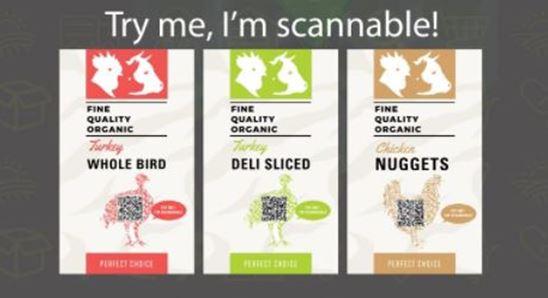
Source: catsquared.com
Reduced costs
Another benefit of blockchain is that it can provide faster payment options and lower costs for stakeholders. The technology improves efficiency in processing transactions. It is not uncommon for growers and farmers to not get paid for weeks. Blockchain provides a solution to this issue. It also helps businesses reduce costs in the supply chain by eliminating middlemen. The reporting and auditing processes can also be eliminated, resulting in faster payment options for participants.
Currently there are several blockchain-based apps designed for secure and low-cost transfers of funds. Smart contracts are also used, as they trigger payments automatically as soon as the buyer confirms a certain condition.
Tips:
- Check whether some of the business problems (transparency and traceability, accountability problems with contracts, international trade transactions) you face could be resolved using blockchain-based solutions. In order for you to determine this, you will have to gather necessary data, assess regulatory requirements and potential interoperability with existing technologies.
- If your customers approach you with the idea of incorporating blockchain into their supply chains, be open to finding a mutually-acceptable solution.
5. Limitations of blockchain
Despite the many benefits that blockchain has to offer for supply chains, it still has many limitations. One of the main disadvantages of blockchain is its high energy consumption.
The technology is very uses a lot of energy, in order to keep a real-time ledger. Every time a new transaction is made, more energy needs to be used to solve it. The miners need to come up with a lot of solutions in real time in order to validate a transaction. Not all blockchain solutions work in the same way. Private and permissioned networks have limited number of nodes and do not have these issues. They use more efficient methods to reach consensus.
Data collection can be very costly for stakeholders, such as farmers. The initial costs of setting up the ledger can be low, but subsequent costs related to collecting the necessary data are substantial. The additional costs related to training staff to use and operate blockchain can also be a drain on resources.
There are also costs associated with hiring developers and managing a team that understands different aspects of blockchain technology, as well as potential licensing and maintenance costs. This represents an obstacle when adopting and implementing the technology in supply chains.
The appropriate policy and regulatory framework is still lacking, which can pose risks for blockchain users and transactions. The technology is in its infancy and policies that would adequately ensure safe application are not yet in place. In the last few years, a number of regulatory changes have been made at national and international level. Some blockchain projects, especially those dealing with currency or cross-border transactions require KYC (Know Your Customer) and AML (Anti Money Laundering) compliance. At the same time, DLT is considered a high-potential technology.
Data protection and privacy are also considered a major issue, as data gathered by blockchain is immutable. For example, the EU GDPR (General Data Protection Regulation) has established the “Right to be Forgotten” whereas once written, blockchain data cannot be removed. This creates many privacy issues. Participants are unable to remove their traces from the system if they decide they do not want them to be there. It is also possible to keep one’s identity unknown in the system. This raises security concerns largely in relation to anti-money laundering activities.
The overall lack of maturity of the technology makes businesses feel hesitant about using it. Blockchain is only a bit more than a decade old. Blockchain is expected to need more time to mature in order for it to become an attractive technology for businesses. The true benefits of DLT can only be taken advantage of when a critical mass of participants is reached. This requires a wide range of stakeholders across the supply chain to be committed to adopting the technology.
The lack of interoperability of blockchain with other platforms and systems that use different technical interfaces and algorithms is another significant limitation. There are also various types of blockchain networks, which operate differently. These networks are not able to communicate with each other and create a so-called “digital island problem”.
Figure 8: Limitations of blockchain technology
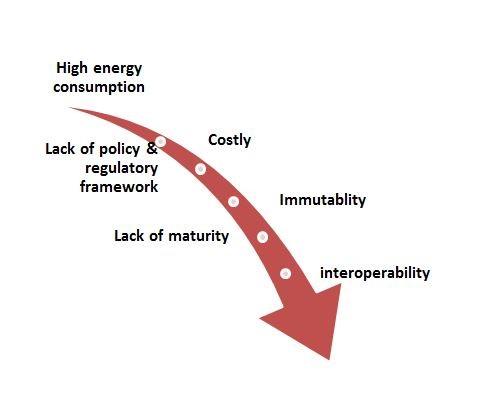
Source: Ecovia Intelligence
Tips:
- You can approach your partners to provide support for the training and maintenance cost related to DLT. Having to cover the cost of participating in blockchain can be a significant burden for small and medium-sized enterprises.
- You can find more information on the potential costs of implementing blockchain applications. See, for example, this blog from Leewayhertz. You can search for other sources yourself.
- Make sure you are aware of the latest GDPR (General Data Protection Regulation) updates and possible implications for blockchain technology. The European Parliament Research Service (EPRS) has written an extensive report about blockchain and GDPR.
6. Applications and case studies
The number of potential applications of Distributed Ledger Technology (DLT) is vast. It can be used in sectors, such as trade finance, certifications, customs, freight and logistics, insurance, distribution and government procurement. Blockchain technology can help improve the efficiency of a number of processes and cut costs in several areas. Natural ingredient suppliers in developing countries should take note of the various applications.
Blockchain applications for finance in agribusiness
Blockchain is a useful technology for addressing a lack of financial transparency. Stakeholders throughout the supply chain have to face issues such as a lack of transparency, credit histories, and difficulties with contract enforcement. The technology provides solutions which help increase the reliability of transactions, improve efficiency and reduce the costs of agricultural financing.
Issues with financial transactions in supply chains can have several negative effects. These include buyers facing problems with ensuring an efficient supply of raw materials and farmers not maximising their yields. For this reason, many farmers do not succeed in selling their products at a fair price. Blockchain can increase the transparency of pricing. Producers can also reach more buyers than they could before, as the whole process is simplified. Blockchain can also increase the effectiveness with regard to conducting audits because blockchain stores data on recorded transactions permanently and securely. The technology could potentially replace the random audits performed by auditors.
Komgo is an example of one such application; it is a blockchain-based trade financing platform and network-based on JP Morgan’s Quorum. The platform is aimed at optimising financing processes and accelerating industry operations. It can be used by traders, carriers, banks, and other authorised participants.
Enhancing agricultural supply chain efficiency
The efficiency of agricultural supply chains is another area where blockchain technology can be a solution. With the fierce competition and increasing globalisation of the food industry, supply chains have become longer and more complex. This causes many issues related to quality, fraud, food safety, traceability, and supply chain inefficiency. Because of the lack of digitalisation, agricultural supply chains lack the required efficiency.
Blockchain technology helps solve a number of these issues by promoting an environment where trust can be established between the producers and consumers. Transparency in this process can be greatly boosted by offering individual product information within the blockchain.
Blockchain technology is capable of recording information throughout the chain from its origins to the retailer. The data collected can be checked and verified by any stakeholder involved in the supply chain. In the current supply chain system, it can become difficult to confirm the origin of products and ingredients. Blockchain can significantly improve the traceability of agricultural products and raw materials, as all information regarding production, transportation, storage and distribution is recorded.
The Singapore-based company Eachmile Technologies has developed a blockchain-based traceability platform called Fishcoin. The system is aimed at increasing security and traceability in the seafood industry. The platform enables the sharing of data, as well as incentives data collection by stakeholders. Fishcoin gives fishermen tokens for topping up their mobile phone data plans in exchange for collecting information on their catch through the use of blockchain technology. The costs for phone plans are covered by the various downstream stakeholders in the supply chain that need the data.
Figure 9: Fishcoin application
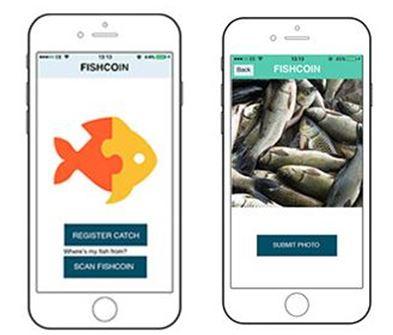
Source: fis-net.com
Improved quality control and food safety
DLT is also used to increase efficiency and quality control throughout the supply chain . There is a level of insufficiency across the sector, because of the lack of automation and technology usage. Small- and medium-sized companies do not have sufficient resources to invest in digitalisation and technology that could increase overall efficiency of their production. By using a blockchain immutable ledger system, data related to quality management and production processes can quickly be accessed, in order to increase the overall safety and efficiency of supply chains.
Decapolis Food Guard is a provider of blockchain-based Food Safety and Quality traceability platform. The application gathers data and measurements at each stage of the production and sourcing processes. The data can be generated instantly as required by an auditor. Decapolis estimates that certification costs can be reduced by 70 percent through the use of this platform.
Smart farming data management
Blockchain technology can also be used in smart farming for enhanced productivity and control management. The combination of smart devices and blockchain enables the removal of ineffective processes. Farmers and growers can monitor data related to soil quality, irrigation, weather conditions and pests in real time. Decisions can be made based on reliable and real-time data. This system gives stakeholders the ability to tackle any problem immediately. If any issues arise, farmers are notified and the problem can be tackled in real time.
Breeder is a new online livestock tool for farmers and processors. The platform uses blockchain to gather animal information directly from farms and make it available in the cloud. The application collects data and is connected to the farm management system. Data is collected about each animal; farmers can get an idea of how quickly each animal is growing and when it could be ready for sale. Farmers and processors can better predict beef supplies at national level and manage their cash flow.
Tip:
- Explore the idea of tokenisation or incentives when it comes to introducing blockchain, for example Fishcoin. Downstream stakeholders have more resources and have a need for reliable data. They may want to reward you for your participation in their blockchain project.
7. Opportunities offered by blockchains
Blockchain is starting to be utilised in many projects, the majority of which are still in their trial or pilot stage. DLT offers a wide range of possibilities to improve productivity, traceability and transparency, but it is still limited by its lack of maturity, poor infrastructure, failures of interoperability. At the same time, the technology has huge potential for use in rural communities, particularly by producers of natural ingredients in developing countries. The main areas of opportunity include supply chain transparency and financial services, such as remittances and banking.
One of the key benefits offered by DLT is increased trust and transparency in supply chains and international trade. The technology can help prevent counterfeiting and improve consumer trust. This is especially true in the case of certified products and raw materials. Studies have shown that the food products that are most prone to food fraud include olive oil, milk, honey, saffron, orange juice, apple juice, grape wine, vanilla extract and fish.
Figure 10: Types of Food Fraud
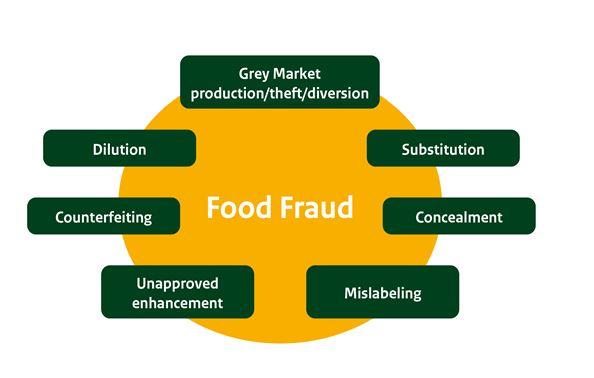
Source: knowledge4policy.ec.europa.eu
Stakeholders in the supply chain could use DLT as a way to provide evidence for the quality, authenticity and traceability of their products and ingredients. Ethical, fair trade and sustainable claims would be verifiable. As a result, this could potentially lead to an increase in sustainable farming practices.
The food company Nestlé and retail chain Carrefour use blockchain technology as members of the IBM Food Trust Blockchain Network to provide transparency and traceability. In 2019, both companies announced that they would add instant mashed potato mix Mousline purée and baby milk to their portfolio of tracked products. In 2020, Nestlé extended IBM blockchain to the Zoégas coffee range. Consumers can scan a QR code and obtain information related to cultivation, treatment, storage and quality.
There is an inherent risk associated with international trade transactions. Financial institutions bridge the gap in the exchange between buyers and sellers with some form of finance, such as credit, insurance and guarantees. Blockchain could enhance security and trust in payment transactions between exporters and importers.
International trade involves multiple copies of agreements between the financial institutions and freight providers, as well as agreements on the value of the shipment and how it is loaded. These complex transaction systems and processes are often inefficient. The current payment terms are time-consuming and both parties are exposing themselves to certain risks. Long periods between transactions and deliveries have a negative impact on the cash flow of importers and exporters.
Trade finance digital platforms using DLTs can bring improve the efficiency of supply chains by reducing costs and the risks for sellers and financial institutions. Blockchain utilises smart contracts to automate the settlement of payments in real time. The technology can enable participation of SME’s by reducing trade costs, facilitating access to trade finances. However, this is only possible if small and medium size producers and companies have sufficient resources and skills to operate and maintain the technology. Addressing the digitalisation gap both in terms of access and bandwidth is of key importance.
Figure 11: Example of the letter of credit process: traditional model vs. blockchain model
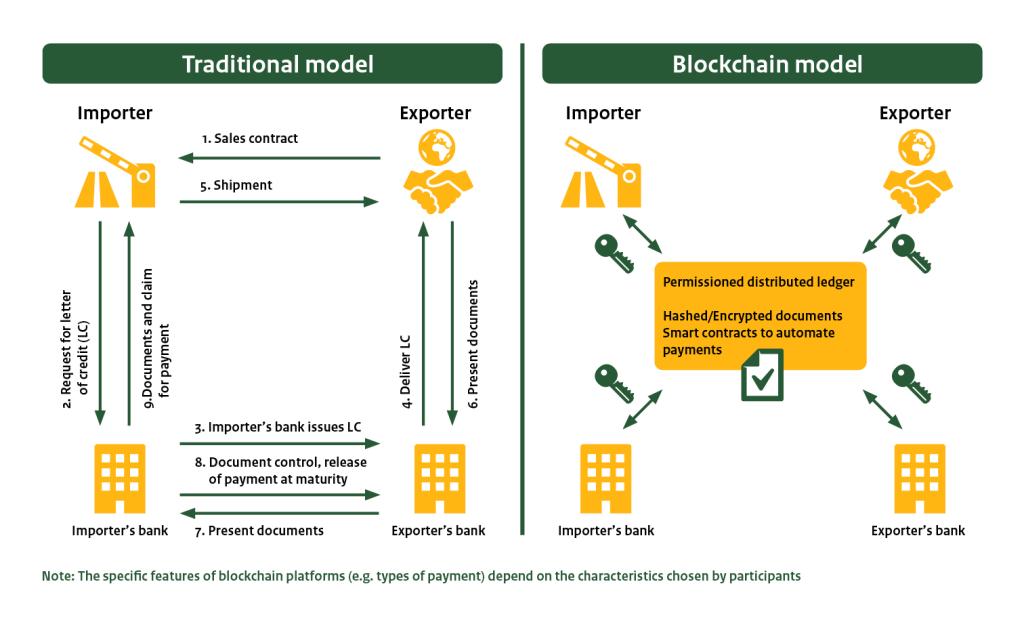
Source: WTO
Incorporating blockchain into supply chains can be costly for companies. The reliability of data recorder onto blockchain is also dependent on the offline verification process. Since the application of blockchain can only be successful if all the necessary stakeholders participate, the large-scale use of DLT in supply chains is not expected in the near future. Due to the extensive resources required for blockchain and the technology’s limitations, it will take many years for its use to rise.
Tips:
- Consider blockchain if the ingredients you supply are prone to fraud. You may be able to charge a premium for supplying raw materials that can be authenticated.
- Carefully choose and then apply the level of digitalisation most relevant for your business. Make sure you are honest about what you are capable of delivering when negotiating with your customers.
8. Conclusions
Blockchain offers a unique opportunity to tackle major problems in raw material supply chains and revolutionise international trade. The technology offers solutions for transparency, traceability, financial transactions, logistics, land ownership, and efficiency of supply chains. It has the potential to help increase the sustainable and ethical sourcing of raw materials from developing countries, whilst minimising fraud and quality issues. According to feedback from European buyers, these are some of the main issues that they face when dealing with exporters from developing countries.
While DLT offers a wide range of opportunities, the technology cannot solve all of the existing problems and its application is limited in a number of ways. Various technical, institutional, infrastructure and capacity development challenges need to be addressed to get the maximum benefit. One of the main challenges that exporters in developing countries face with regard to blockchain is a lack of digital skills, infrastructure and resources.
Suppliers of natural ingredients from developing countries should continue to expand their knowledge of blockchain. They should identify areas in which technical assistance is needed to prepare for blockchain. As European buyers continue to look into new ways to improve the traceability of their supply chains, it is possible that buyers will consider using blockchain in future.
You should prepare for blockchain by taking stock of any necessary data on your raw materials that may be required. Introducing digitalisation into your strategy may also help prepare you in case some of your partners express interest in blockchain.
Incorporating a DLT platform into a supply chain requires careful planning, consideration and coordination among potential participants. Users have to invest substantial resources into such a project over a long period. There are less demanding alternatives that could be more suitable for you and your partners. You should communicate to your buyers what you can realistically commit to.
Tip:
- If you need technical assistance to prepare for the introduction of blockchain, you may want to take advantage of services that some companies provide. You can find examples of such providers on the internet.
This study was carried out on behalf of CBI by Ecovia Intelligence.
Please review our market information disclaimer.
Search
Enter search terms to find market research